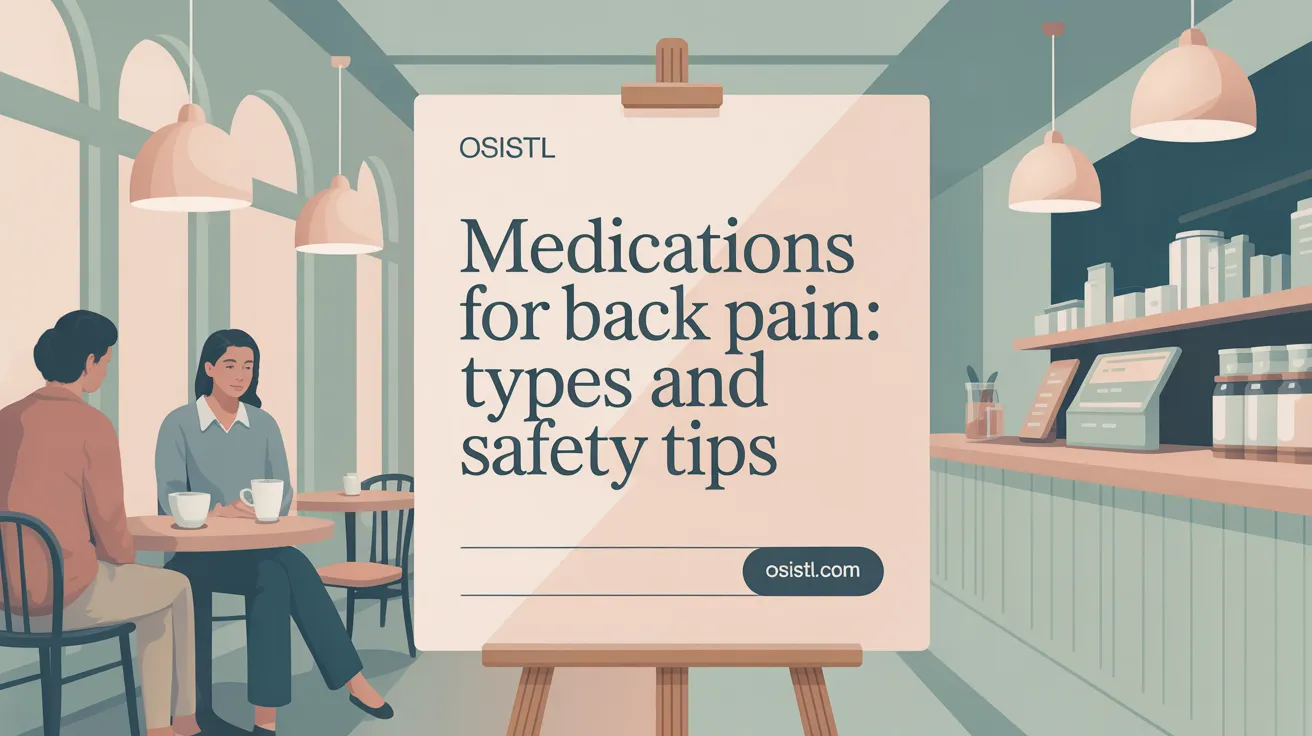Understanding Back Pain: Causes, Symptoms, and Diagnosis
Back pain is a ubiquitous health issue affecting millions worldwide, characterized by discomfort ranging from mild to debilitating. It can arise from a variety of causes including musculoskeletal strains, degenerative spine conditions, or underlying medical disorders. Accurate diagnosis and early management are essential to prevent chronicity and improve quality of life. This article explores effective strategies for treating back pain, emphasizing evidence-based approaches across medical, physical, and holistic disciplines, aiming to guide readers through understanding, managing, and preventing back pain.
Common Causes, Symptoms, and Diagnostic Methods for Back Pain
 Back pain is a widespread health issue with various causes, symptoms, and approaches for diagnosis. Understanding the common reasons behind back discomfort is essential for proper management.
Back pain is a widespread health issue with various causes, symptoms, and approaches for diagnosis. Understanding the common reasons behind back discomfort is essential for proper management.
Causes of back pain
Back pain can stem from multiple sources. Musculoskeletal causes include muscle or ligament strains, often resulting from heavy lifting, sudden movements, or poor posture. Degenerative conditions such as herniated or bulging disks, osteoarthritis, and spinal stenosis contribute to chronic pain, especially in older adults. Fractures related to osteoporosis or trauma, infections like osteomyelitis, and even tumors can also cause back pain.
Underlying medical conditions, such as kidney stones or gastrointestinal issues, may refer pain to the back, complicating diagnosis. Bad ergonomics, prolonged sitting, and lifestyle factors like smoking can exacerbate or contribute to back problems.
Symptoms of back pain
Symptoms vary depending on the underlying cause but typically include localized pain, stiffness, and muscle spasms. The pain can be dull and achy or sharp and stabbing, sometimes radiating down the buttocks, legs, or feet — a condition known as sciatica.
Additional symptoms to watch for include weakness, numbness, tingling in the legs, or loss of bladder or bowel control, which may signal serious neurological issues. Fever or night pain could suggest infection or malignancy, requiring prompt medical evaluation. See Serious back pain symptoms for guidance.
Diagnostic approaches
Diagnosing back pain involves a detailed medical history and physical exam. The healthcare provider will assess pain location, duration, and associated symptoms, along with testing neurological function.
Imaging studies are crucial if pain persists beyond a few weeks, worsens, or if red flags such as neurological deficits are present. X-rays can reveal fractures or degenerative changes, while MRI provides detailed images of soft tissues like disks and nerves. Blood tests might be ordered if an infection or tumor is suspected.
In some cases, additional procedures like electromyography (EMG) help evaluate nerve function. Treatment strategies generally include rest, physical therapy, medications, and home remedies. Surgery may be considered in severe cases involving neurological impairment, fractures, or tumors.
Evidence-Based Treatment Options for Back Pain
Back pain management involves a comprehensive set of strategies tailored to individual needs. Non-surgical treatments form the first line of defense and encompass physical therapy, lifestyle modifications, and alternative therapies. Physical therapy plays a pivotal role; it focuses on tailored exercises to strengthen core muscles, improve flexibility, and retrain posture, which can significantly reduce pain and prevent recurrence. Typical programs include core strengthening, stretching, postural training, and aerobic exercises. These approaches have shown to provide up to 60% improvement in symptoms.
Medications are often used to manage pain effectively. Nonsteroidal anti-inflammatory drugs (NSAIDs) like ibuprofen and naproxen help reduce inflammation, while muscle relaxants alleviate spasms. In cases of nerve pain, medications such as anticonvulsants and antidepressants may be prescribed. Opioids are generally reserved as a last option due to their risks, including dependence and side effects. Other pharmacological options include topical pain relievers and, in some cases, corticosteroid injections, which help control inflammation temporarily.
Lifestyle changes are crucial for long-term relief. Maintaining a healthy weight reduces strain on the spine, smoking cessation improves blood flow and tissue health, and ergonomic adjustments in the workplace help prevent aggravation. Activities like yoga, tai chi, and mindfulness meditation also support emotional and physical wellness, aiding in pain management.
For more severe or persistent back pain, interventional procedures such as epidural steroid injections, nerve blocks, and nerve ablations provide targeted pain relief. In carefully selected cases—especially those presenting red flag symptoms like worsening neurological deficits or structural abnormalities—surgical options such as discectomy or spinal fusion may be considered. Surgery is viewed as a last resort when conservative measures have failed, and only after thorough evaluation with imaging and specialist consultation.
Overall, successful back pain treatment involves an integrated approach—combining physical, medical, and lifestyle strategies—aimed at reducing pain, improving function, and enhancing quality of life.
Self-Management Strategies: Exercises, Stretches, and Home Remedies

What self-management techniques, such as exercises, stretches, posture correction, and home remedies, can help alleviate back pain?
Dealing with back pain often starts with adopting effective self-management strategies that can be performed at home. Regular engagement in low-impact exercises, such as walking, swimming, yoga, and Pilates, helps strengthen core muscles, improve flexibility, and support spinal stability. These activities are gentle on the back but highly effective in reducing pain and preventing future discomfort (exercise for chronic low back pain, Yoga for back pain relief, Physical Therapy for Back Pain, Exercises for Lower Back Pain).
Stretching exercises are also beneficial for relieving muscle tension and enhancing mobility. Simple stretches like the child’s pose, cat-cow pose, thoracic spine rotations, and hip openers help loosen tight muscles and maintain spinal flexibility. Incorporating these routines daily can significantly reduce muscle spasms and improve overall back health (Lower Back Pain Stretches, Physical therapy exercises, Stretching exercises for back pain).
Proper posture plays a crucial role in back pain management. Ergonomic adjustments at work, such as an appropriately adjusted chair and monitor placement, along with posture correction exercises, help reduce strain on the spine. Practices like lumbar support, maintaining a neutral spine during daily activities, and techniques like pelvic tilts or seated stretches support spinal alignment (Poor Posture Effects on Back Pain, Ergonomic workstation setup, Posture improvement exercises).
Home remedies like applying heat or cold packs are straightforward yet effective. Cold therapy can decrease inflammation immediately after injury, while heat therapy relaxes muscles and improves blood flow, promoting healing. Massage therapies and topical pain-relief creams containing menthol or CBD may provide short-term relief from pain (Back pain home remedies, Heat therapy for back pain, Massage therapy for back pain).
Lifestyle modifications are essential for long-term back health. Managing weight reduces undue stress on the spine, while quitting smoking improves blood flow to tissues, aiding healing. Stress reduction techniques such as mindfulness and deep breathing can alleviate muscle tension. Ensuring proper sleep positions (like sleeping on the side with a pillow between the knees) minimizes spinal strain and supports back recovery (Lifestyle habits for back pain, Mindfulness and Meditation, Proper sleep posture for back pain relief).
By adopting these self-management techniques, individuals can effectively reduce back pain, maintain mobility, and improve quality of life. Consistency and proper technique are vital to achieve optimal results, and consulting healthcare professionals for personalized guidance enhances safety and efficacy (Back pain self-care tips, Consulting healthcare professionals for back pain).
Medications for Back Pain: Types, Uses, and Safety Considerations
 Medications for back pain vary widely depending on the severity of pain, underlying cause, and individual health factors. Over-the-counter options like acetaminophen use in acute back pain and NSAIDs for back pain are commonly used for managing mild to moderate pain. Acetaminophen (Tylenol) is preferred for its safety profile, especially in cases where inflammation is minimal or when NSAIDs are contraindicated. NSAIDs such as ibuprofen and naproxen help reduce inflammation and pain related to muscle strain, arthritis, or injury, but they may cause gastrointestinal issues, kidney problems, or cardiovascular concerns if used long-term or in higher doses as explained in Medications for Back Pain Relief.
Medications for back pain vary widely depending on the severity of pain, underlying cause, and individual health factors. Over-the-counter options like acetaminophen use in acute back pain and NSAIDs for back pain are commonly used for managing mild to moderate pain. Acetaminophen (Tylenol) is preferred for its safety profile, especially in cases where inflammation is minimal or when NSAIDs are contraindicated. NSAIDs such as ibuprofen and naproxen help reduce inflammation and pain related to muscle strain, arthritis, or injury, but they may cause gastrointestinal issues, kidney problems, or cardiovascular concerns if used long-term or in higher doses as explained in Medications for Back Pain Relief.
For muscle spasms and acute discomfort, muscle relaxants like cyclobenzaprine or baclofen are prescribed. These drugs act on the central nervous system and can cause drowsiness, dizziness, and confusion, requiring careful monitoring (Muscle Relaxants for Back Pain). Neuropathic pain medications, including gabapentin, pregabalin, and certain antidepressants like duloxetine, are employed when nerve involvement contributes to chronic back pain. They offer relief from nerve pain but can cause side effects such as weight gain, drowsiness, or skin rashes (Medications for Back Pain).
Antidepressants actually serve a dual purpose in some cases, helping both to manage pain and improve sleep, with medications like duloxetine and amitriptyline being popular choices (Pharmacologic Treatments for Back Pain). Opioids are reserved for severe, persistent pain and are used cautiously due to risks of dependence, tolerance, and overdose. They should be prescribed at the lowest effective dose and for the shortest duration possible, with vigilant medical oversight (Risks of Opioid Use and Risks of Opioids).
Always seek guidance from a healthcare professional before initiating or changing medications for back pain. They can evaluate your specific condition, monitor for adverse effects, and help develop a balanced treatment plan designed to minimize risks while effectively managing pain (Consulting healthcare professionals for back pain).
Alternative and Complementary Therapies for Back Pain Relief
Many individuals seeking relief from back pain turn to alternative therapies for chronic back pain and complementary therapies to supplement conventional treatments. These approaches can help reduce pain, relax tense muscles, and improve overall well-being.
One popular therapy is acupuncture for back pain, which involves inserting fine needles at specific points on the body. This technique may stimulate nerve fibers and release endorphins, providing pain relief. Studies suggest acupuncture offers a modest benefit for both acute and chronic back pain, making it a reasonable option to consider.
Massage therapy is another widely used method. Techniques such as Swedish massage, deep-tissue work, or trigger point therapy can alleviate muscle tension, improve circulation, and promote relaxation. While scientific evidence varies, many people experience short-term pain reduction and increased mobility after massage sessions.
Chiropractic care focuses on spinal adjustments and manipulation aimed at restoring proper alignment and function. Chiropractic interventions can provide relief for certain back conditions, especially when combined with exercises and other therapies. It is essential to seek care from qualified professionals and discuss any underlying health issues beforehand.
Mindfulness-based practices, including yoga and tai chi, are effective for managing back pain through gentle movement, stretching, and stress reduction. These practices help improve flexibility, strength, balance, and mental resilience, which can decrease perceived pain and enhance quality of life.
Biofeedback is a technique where electrical sensors monitor physiological responses such as muscle tension or heart rate. Individuals learn to control these responses, reducing muscle spasms and pain levels. Biofeedback is particularly helpful for managing stress-related back discomfort.
In addition to these, other holistic methods like guided imagery, herbal remedies, energy therapies such as reiki, and therapeutic touch may provide supplementary benefits. Evidence supporting their effectiveness varies, and individual responses differ.
It is crucial to consult healthcare providers before beginning any new therapy to ensure it fits within a comprehensive treatment plan and does not interfere with existing medications or conditions. Combining these therapies with conventional approaches offers a balanced strategy for managing back pain effectively.
Preventive Measures and Health Education to Maintain Spinal Health

What preventive measures and health education strategies can help maintain spinal health and reduce the risk of back pain?
Maintaining a healthy and resilient spine involves adopting a comprehensive approach that combines lifestyle habits for back pain, physical activity, and ergonomic awareness. Regular stretching and strengthening routines, such as yoga for back pain, Pilates, and core-focused exercises, are fundamental. These activities help develop the muscles that support the spine, improving stability and reducing the likelihood of injury.
Proper posture during daily activities, especially when sitting at desks or lifting heavy objects, is critical. Learning and practicing safe body mechanics—such as bending at the hips and knees, keeping objects close to the body, and avoiding twisting motions—can significantly decrease strain on spinal structures (proper lifting techniques).
Weight management plays a vital role. Excess body weight, especially around the abdomen, places additional stress on the lower back. Maintaining a healthy weight through a balanced diet and regular physical activity can help prevent back problems (healthy weight to reduce back strain).
A diet rich in calcium and vitamin D supports bone strength, reducing the risk of osteoporosis-related fractures or degeneration (calcium and vitamin D for osteoporosis). Incorporating anti-inflammatory foods such as colorful vegetables, fatty fish, nuts, and seeds can also help decrease inflammation that contributes to back pain (anti-inflammatory diet for back pain).
Lifestyle changes like taking frequent breaks from prolonged sitting, using ergonomic furniture, and maintaining proper sitting and standing posture help alleviate unnecessary stress on the back (ergonomic workstation setup, proper posture maintenance).
Smoking cessation is equally important. Smoking impairs blood flow to spinal discs and bones, accelerating degeneration and increasing the risk of fractures. Quitting smoking supports better tissue oxygenation and overall spinal health (effects of smoking on spinal health).
Educational efforts that teach individuals about proper posture, safe lifting techniques, and stress management for back pain can empower them to make healthier choices. Additionally, seeking early intervention through physical therapy or medical advice when experiencing pain or discomfort helps prevent minor issues from becoming chronic conditions.
Incorporating these strategies into daily routines can lead to long-term spinal health, reduce the incidence of back pain, and improve overall quality of life.
When to Seek Medical Help: Recognizing Warning Signs and Red Flags
 Individuals experiencing back pain should consider seeking medical attention if their symptoms are severe, persistent beyond a few weeks, or worsening despite home treatment for back pain. Not all back pain requires urgent care, but certain red flag symptoms and signs indicate a need for prompt evaluation.
Individuals experiencing back pain should consider seeking medical attention if their symptoms are severe, persistent beyond a few weeks, or worsening despite home treatment for back pain. Not all back pain requires urgent care, but certain red flag symptoms and signs indicate a need for prompt evaluation.
Signs that warrant professional intervention include numbness, tingling, or weakness in the limbs, which may suggest nerve compression or nerve damage. Radiation of pain down the legs or arms (such as sciatica) is also a red flag.
Trauma-related back pain, such as after a fall, accident, or injury, especially with severe or worsening symptoms, requires immediate assessment to rule out fractures or other serious injuries.
Systemic signs like fever, unexplained weight loss, or night sweats could signal infections or malignancy affecting the spine, demanding urgent medical evaluation.
Additional urgent indicators include loss of bladder or bowel control, severe pain unrelieved by medication, swelling, skin discoloration over the back, or new weakness or paralysis.
If you notice any of these warning signs, it's essential to see a healthcare professional promptly. Early diagnosis and treatment can prevent complications, address serious underlying conditions, and improve the chances of effective pain management.
For more detailed information on when to seek help for back pain, search for "red flags when to seek medical help back pain".
Integrating Strategies for Optimal Back Pain Management
Effectively managing back pain requires a multifaceted approach that integrates accurate diagnosis, evidence-based treatments, self-care techniques, and preventive measures. Individuals benefit most from personalized plans that incorporate physical therapy, appropriate medication usage, lifestyle modifications, and psychological support when needed. Alternative therapies serve as valuable adjuncts to traditional methods, helping enhance pain relief and functionality. Awareness of warning signs that necessitate medical evaluation ensures timely intervention for serious conditions. Ongoing research and innovations continue to refine treatment protocols, aiming to improve patient outcomes. By adopting a holistic, informed strategy, patients can attain better control over their back pain, reduce disability, and enhance overall quality of life.
